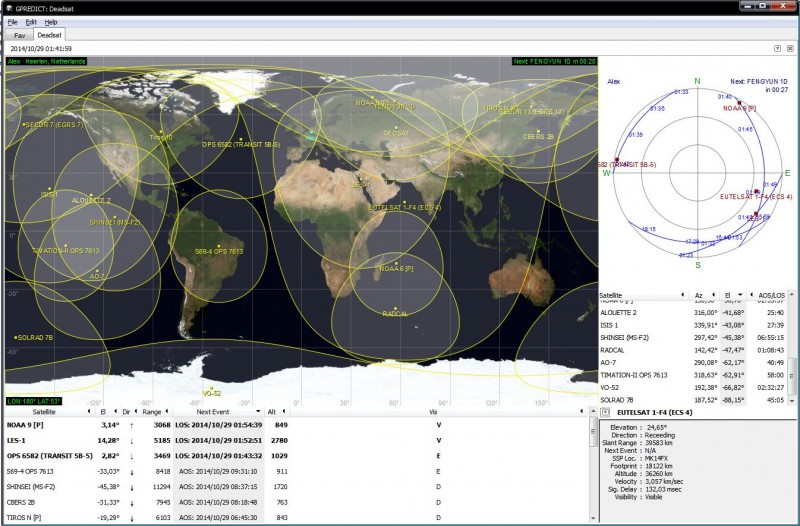Halloween may be over, but [happysat] has found a way to listen to the dead. Satellites, that is, specifically those in the 136-138 MHz and 150-400 MHz ranges. He’s using an RTL-SDR dongle and a QFH antenna to detect the death throes of decommissioned navigation and space research satellites.
[happysat] was listening to NOAA/Meteor on the 137MHz band when he made this discovery. When a satellite is near end of life, the last bit of fuel is used to push it into graveyard orbit. This doesn’t always work, however, and when the light is just right, a chemical reaction makes the long-dead batteries conduct and these satellites in purgatory transmit once more.
They’re not sending out anything proprietary useful, just unmodulated carrier that sometimes interferes with currently operational satellites on the 136-138 MHz band. [happysat] captured some audio from two of the oldest satellites that are still broadcasting, and links to a TLE set of dead satellites he created. Check out his frequency database for SDR# as well. Don’t have a weather satellite-capable antenna? Build one!
[via /r/RTLSDR]
















This is cool, gotta admit.
It’s not dead, it’s just resting.
It’ll be stone dead in a moment
It’s only mostly dead. Mostly dead is a little bit alive. A little bit alive he can work with.
Hellp, I wish to complain about this satellite that I launched not half a century ago from this very space center.
Oh yes, the, uh, the Transit 5B-5…What’s,uh…What’s wrong with it?
I’ll tell you what’s wrong with it, my lad. ‘E’s dead, that’s what’s wrong with it!
No, no, ‘e’s uh,…he’s resting.
Look, matey, I know a dead satellite when I see one, and I’m looking at one right now.
No no he’s not dead, he’s, he’s restin’! Remarkable satellite, the Transit 5B-5, idn’it, ay? Beautiful solar panels!
The solar panels don’t enter into it. It’s stone dead.
Nononono, no, no! ‘E’s resting!
All right then, if he’s restin’, I’ll wake him up! ‘Ello, Mister satalite! I’ve got a lovely fresh sunbeam for you if you transmit!
…That was fun, I kinda want to dub the video now.
-uhp- you’ve stunned ‘im!
‘B-5’s stun easily y’know
Its just a flesh wound!
Oh that’s cool- it also explains the mystery signals I got from my weather satellite receiver. Who would guess those ancient satellites are still bleeping about.
I wonder if we could build a distributed SDR satellite receiver. There’s enough people with SDR’s and copper pipe to do it. Honestly, you could pick up an incredible amount of data with that.
I think thats the goal of satnogs project.
The coolest one of these is LES-1, currently the oldest satellite confirmed still transmitting. It was launched in 1965. It’s around 237MHz
Here’s some links:
http://www.southgatearc.org/news/february2013/radio_archeology.htm#.VFoXbGNBl1H
http://nerdsville.blogspot.fi/2013/03/receiving-les1-satellite-built-in-1965.html
http://en.wikipedia.org/wiki/Lincoln_Experimental_Satellite
I’m yet to receive it myself as my UHF SATCOM antenna still sits in the garage.
I’m pretty sure 237 MHz is considered the high end of VHF, not UHF.
And that’s what the military calls it. The new satellites are even called “UHF Follow On” (or UFO for short, I bet that got a few laughs around the folks deciding on the name).
But yeah, it really is VHF, but it is called UHF in the industry. ” UHF-Satcom generally refers to frequencies between 240MHz and 270MHz.”
Here’s a good site with some info on frequencies:
http://www.uhf-satcom.com/uhf/
All about…
http://www.satellitenwelt.de/uhfmilsat.htm
Cool, don’t see a real use for it but still cool.
We need to keep listening to these “resting” satelites, so we know if evil aliens start to use them to communicate with their motherships.
It’d be nice to find the command frequencies for these satellites and give them second lives. I mean, so long as they’re barfing all over the radio spectrum…
Yeah, any news on the ISEE or whatever it’s called resurrection?
I had a hilarious idea: integrate a uNANO SDR onto a weather balloon as an altimeter.
Also for observation it would be handy to receive ground stations and other signals.